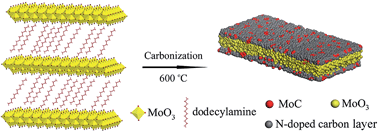N-doped carbon encapsulated ultrathin MoO3 nanosheets as superior anodes with high capacity and excellent rate capability for Li-ion batteries†
Abstract
Molybdenum oxide is an attractive anode material for lithium ion batteries because of its environmental benignity and high capacity. However, molybdenum oxide suffers from serious capacity fading caused by large volume changes and poor rate capability due to low conductivity. In this work, ultrathin N-doped carbon layer encapsulated MoO3 nanosheets have been synthesized by a simultaneous pyrolysis–reduction process of dodecylamine-intercalated MoO3 composites at 600 °C under a nitrogen atmosphere. This special 2D nanosheet morphology can greatly shorten the diffusion length of both electrons and ions, which can ensure the fast kinetics of Li+ intercalation and deintercalation, resulting in high rate performance. Furthermore, N-doped carbon encapsulated MoO3 nanosheets exhibited good electrical conductivity, uniform dispersion and ultrathin thickness. On the basis of these combined effects, the as-fabricated nanosheets can reach high initial charge and discharge capacities of 1610 and 1359 mA h g−1, respectively, and show remarkable cycle stability with a specific capacity of 1250 mA h g−1 after 60 cycles at 0.3C rate. High specific discharge capacities are maintained at fast C rates, e.g., 1370, 1010, 940, 610, 490 and 370 mA h g−1 at 0.3C, 1C, 2C, 4C, 10C, and 20C, respectively.

- This article is part of the themed collection: 2015 Journal of Materials Chemistry A Hot Papers

 Please wait while we load your content...
Please wait while we load your content...